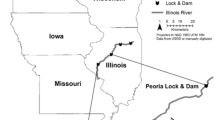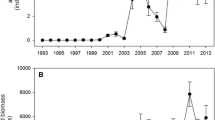Abstract
Common carp (Cyprinus carpio, carp) are a widespread and ecologically destructive invasive fish species. Carp management is critical for maintaining healthy aquatic ecosystems, and many control options are available, but most have proven to be ineffective. Carp abundances have increased at The Nature Conservancy’s Emiquon Preserve, Illinois, since its restoration in 2007 despite management efforts to suppress this species. We conducted a comparative diet study in Illinois, Tennessee, and Wisconsin to test whether bowfin (Amia calva), spotted gar (Lepisosteus oculatus, gar), and largemouth bass (Micropterus salmoides) commonly preyed upon carp. We focused on bowfin and gar because they are hypoxia-tolerant, similar to carp. We also assessed whether specific fish community characteristics were correlated with carp relative abundances. We found no evidence that bowfin, gar, and bass consumed large numbers of carp. However, carp may be limited in some ecosystems (e.g., Reelfoot Lake, Tennessee) through alternative mechanisms associated with bowfin, gar, bass, and bluegill (Lepomis macrochirus) included in a diverse native fish community.







Similar content being viewed by others
References
Ahrenstorff, T. D., G. G. Sass & M. R. Helmus, 2009. The influence of littoral zone coarse woody habitat on home range size, spatial distribution, and feeding ecology of largemouth bass (Micropterus salmoides). Hydrobiologia 623: 223–233.
Allendorf, F. W. & L. L. Lundquist, 2003. Introduction: population biology, evolution, and control of invasive species. Conservation Biology 17: 24–30.
Ashley, K. W. & R. T. Rachels, 1999. Food habits of bowfin in the Black and Lumber river, North Carolina. Southeastern Association of Fish and Wildlife Agencies 53: 50–60.
Bajer, P. G. & P. W. Sorensen, 2010. Recruitment and abundance of an invasive fish, the common carp, is driven by its propensity to invade and reproduce in basins that experience winter-time hypoxia in interconnected lakes. Biological Invasions 12: 1101–1112.
Bajer, P. G., G. Sullivan & P. W. Sorensen, 2009. Effects of a rapidly increasing population of common carp on vegetative cover and waterfowl in a recently restored Midwestern shallow lake. Hydrobiologia 632: 235–245.
Bajer, P. G., C. J. Chizinski, J. J. Silbernagel & P. W. Sorensen, 2012. Variation in native micro-predator abundance explains recruitment of a mobile invasive fish, the common carp, in a naturally unstable environment. Biological Invasions 14: 1919–1929.
Barrio, I. C., C. G. Bueno, P. B. Banks & F. S. Tortosa, 2010. Prey naiveté in an introduced prey species: the wild rabbit in Australia. Behavioral Ecology 21: 986–991.
Beals, M., L. Gross & S. Harrell, 2000. Diversity indices: Shannon’s H and E. [internet]. Accessed Dec 3, 2013. [available at http://www.tiem.utk.edu/~gross/bioed/bealsmodules/shannonDI.html.]
Carey, M. P. & D. H. Wahl, 2010. Native fish diversity alters the effects of an invasive species on food webs. Ecology 91: 2965–2974.
Catford, J. A., R. Jansson & C. Nilsson, 2009. Reducing redundancy in invasion ecology by integrating hypotheses into a single theoretical framework. Diversity and Distributions 15: 22–40.
Colautti, R. I., A. Ricciardi, I. A. Grigorvich & H. J. MacIsaac, 2004. Is invasion success explained by the enemy release hypothesis? Ecology Letters 7: 721–733.
Cox, J. G. & S. L. Lima, 2006. Naiveté and an aquatic-terrestrial dichotomy in the effects of introduced predators. Trends in Ecology and Evolution 21: 674–680.
Deangelis, D. L., D. K. Cox & C. C. Coutant, 1979. Cannibalism and size dispersal in young-of-the-year largemouth bass: experiment and model. Ecological Modeling 8: 133–148.
Devlin, J. R., 1999. A trend study of common carp in Pentenwell and Castle Rock reservoirs, Wisconsin, and the spring and summer diet of bowfin in the reservoirs. Master’s Thesis. University of Wisconsin-Stevens Point.
Eagle Spring Lake Management District, 2011. A lake management plan for Eagle Spring Lake in Waukesha County. Community Assistance Planning Report 2011 (226)
Fretueg, G. R, 2012. Latrine site selection and diet composition of river otters (Lontra canadensis) in a restored Illinois floodplain. Master’s Thesis. University of Illinois at Springfield.
Gaeta, J. W., T. R. Hrabik, G. G. Sass, B. M. Roth, S. J. Gilbert & M. J. Vander Zanden, 2015. A whole-lake experiment to control invasive rainbow smelt (Actinopterygii, Osmeridae) via overharvest and a food web manipulation. Hydrobiologia 746: 433–444.
Gregory, M. J., 2013. The biology web: Shannon-Weiner Diversity Index. [internet] Accessed Dec 3, 2013. [available at http://faculty.clintoncc.suny.edu/faculty/michael.gregory/files/bio%20206/206%20laboratory/species%20diversity/species_diversity.htm.]
Gutreuter, S., R. Burkhardt & K. Lubinski, 1995. Long Term Resource Monitoring Program Procedures: Fish Monitoring. National Biological Service, Environmental Management Technical Center, Onalaska, WI.
Havera, S. P., K. E. Roat & L. L. Anderson, 2003. The Thompson Lake Emiquon story: the biology, drainage, and restoration of an Illinois River bottomland lake. Natural History Survey, Special Publication, Springfield.
Heussner, B., S. Gospodarek & A. Notbohm, 2008. Comprehensive survey report of Eagle Spring Lake-Waukesha County (WBIC 0768600) and Lulu Lake-Walworth County (WBIC 768800). Wisconsin Department of Natural Resources Report.
Heussner, B., S. Gospodarek & A. Notbohm, 2009. Comprehensive survey report of Upper Phantom Lake (WBIC 766000) and Lower Phantom Lake (WBIC 765800). Wisconsin Department of Natural Resources Report.
Hodgson, J. R. & J. F. Kitchell, 1987. Opportunistic foraging by largemouth bass (Micropterus salmoides). American Midland Naturalist 118: 323–336.
Hoffman, R. D. & R. D. Curnow, 1979. Mercury in herons, egrets, and their foods. The Journal of Wildlife Management 43: 85–93.
Homans, F. R. & D. J. Smith, 2013. Evaluating management options for aquatic invasive species: concepts and methods. Biological Invasions 15: 7–16.
Johnson, J. M. & D. M. Post, 1996. Morphological constraints on intracohort cannibalism in age-0 largemouth bass. Transactions of the American Fisheries Society 125: 809–812.
Lagler, K. F. & F. V. Hubbs, 1940. Food of the long-nosed gar (Lepisosteus osseus oxyurus) and the bowfin (Amia calva) in Southern Michigan. American Society of Icthyologists and Herpetologists 4: 239–241.
Ludsin, S. A. & D. R. Devries, 1997. First-year recruitment of largemouth bass: the interdependency of early life stages. Ecological Applications 7: 1024–1038.
Michaels, N. N., 2011. Biomanipulation of the largemouth bass Micropterus salmoides population to control invasive species and eutrophication at The Nature Conservancy’s Emiquon Preserve. Master’s Thesis. Western Illinois University, Macomb.
Mundahl, N. D., C. Mclnytschuk, D. K. Spielman, J. P. Horkins, K. Funk & A. M. Bilicki, 1998. Effectiveness of bowfin as a predator on bluegill in a vegetated lake. North American Journal of Fisheries Management 18: 286–294.
Nentwig, W., 2007. Biological Invasions, Vol. 193. Springer, New York.
Oates, D. W., L. M. Krings & K. L. Ditz, 1993. Field manual for the identification of selected North American freshwater fish by fillets and scales. Other Publications in Wildlife Management. Paper 13. http://digitalcommons.unl.edu/icwdmother/13.
Penne, C. R. & C. L. Pierce, 2008. Seasonal distribution, aggregation, and habitat selection of common carp in Clear Lake, Iowa. Transactions of the American Fisheries Society 137: 1050–1062.
Phantom Lakes Management District, 2012. Upper Phantom Lake and Lower Phantom Lake water report 2012. University of Wisconsin-College of Natural Resources and Center for Wetland Science and Education. Upper and Lower Phantom lakes in Waukesha County.
Robertson, C. R., S. C. Zeug & K. O. Winemiller, 2007. Associations between hydrological connectivity and resource partitioning among sympatric gar species (Lepisosteidae) in a Texas river and associated oxbows. Ecology of Freshwater Fish 17: 119–129.
Sammons, S. M. & M. J. Maceina, 2006. Changes in diet and food consumption of largemouth bass following large-scale hydrilla reduction in Lake Seminole, Georgia. Hydrobiologia 560: 109–120.
Sass, G. G., C. M. Gille, J. T. Hinke & J. F. Kitchell, 2006. Whole-lake influences of littoral structured complexity and prey body morphology on fish predator-prey interactions. Ecology of Freshwater Fish 15: 301–308.
Scarnecchia, D. L., 1992. A reappraisal of gars and bowfins in fishery management. Fisheries 17: 6–12.
Schindler, D. E., J. R. Hodgson & J. F. Kitchell, 1997. Density-dependent changes in individual foraging specialization of largemouth bass. Oecologia 110: 592–600.
Seaburg, K. G., 1957. A stomach sampler for live fish. Progressive Fish-Culturist 19: 137–139.
Silbernagel, J. J. & P. W. Sorenson, 2013. Direct field and laboratory evidence that a combination of egg and larval predation controls recruitment of invasive common carp in many lakes of the Upper Mississippi River Basin. Transactions of the American Fisheries Society 142: 1134–1140.
Simberloff, D., J.-L. Martin, P. Genovesi, V. Maris, P. A. Wardle, J. Aronson, F. Courchamp, B. Galil, E. Garcia-Berthou, M. Pascal, P. Pysek, R. Sousa, E. Tabacchi & M. Vila, 2013. Impacts of biological invasions: what’s what and the way forward. Trends in Ecology and Evolution 28: 58–66.
Snedden, G. A., W. E. Kelso & D. A. Rutherford, 1999. Diel and seasonal patterns of spotted gar movement and habitat use in the lower Atchafalaya River Basin, Louisiana. Transactions of the American Fisheries Society 128: 144–154.
Tennessee Wildlife Resources Agency, 2009. Habitat Enhancement and Monitoring Report.
Tennessee Wildlife Resources Agency, 2013. Reelfoot Lake general fishing information. Web. http://www.reelfoot.com/general_fishing_info.htm.
Tockner, K. & J. A. Stanford, 2002. Riverine flood plains: present state and future trends. Environmental Conservation 29: 308–330.
Toole, J. E., 1971. Food Study of the Bowfin and Gars in Eastern Texas, Vol. 6. Texas Parks and Wildlife Department.
Traynor, D., A. Moerke & R. Greil. 2010. Identification of Michigan Fishes using Cleithra. Great Lakes Fishery Commission Miscellaneous Publication 2010-02.
Tyler, J. D., 1984. Notes on food habits, size, and spawning behavior of spotted gar in Lake Lawtonka, Oklahoma. Proceedings of the Oklahoma Academy of Sciences 64: 8–10.
Vander Zanden, M. J., G. J. A. Hansen, S. N. Higgins & M. S. Kornis, 2010. A pound of prevention, plus a pound of cure: early detection and eradication of invasive species in the Laurentian Great Lakes. Journal of Great Lakes Research 36: 199–205.
VanMiddlesworth, T. D., N. N. Michaels & A.F. Casper, 2014. The Nature Conservancy’s Emiquon Preserve Fish and Aquatic Vegetation Monitoring 6-year (2007–2012) Report. INHS Technical Report (01).
VanMiddlesworth, T. D., N. N. McClelland, G. G. Sass, A. F. Casper, T. W. Spier & M. J. Lemke, 2016. Fish community succession and biomanipulation to control two common aquatic ecosystem stressors during a large-scale floodplain lake restoration. Hydrobiologia. doi:10.1007/s10750-016-2696-8.
Walker, R. H., E. R. Kluender, T. E. Inebnit & S. R. Adams, 2013. Differences in diet and feeding ecology of similar-sized spotted (Lepisosteus oculatus) and shortnose (Lepisosteus platostomus) gars during flooding of a south-eastern US river. Ecology of Freshwater Fish 22: 617–625.
Weber, M. J. & M. L. Brown, 2009. Effects of common carp on aquatic ecosystems 80 years after “carp as a dominant”: ecological insights for fisheries management. Reviews in Fisheries Science 17: 524–537.
Weber, M. J. & M. L. Brown, 2011. Relationships among invasive common carp, native fishes and physicochemical characteristics in upper Midwest (USA) lakes. Ecology of Freshwater Fish 20: 270–278.
Weber, M. J., M. L. Brown & D. W. Willis, 2010. Spatial variability of common carp populations in relation to lake morphology and physicochemical parameters in the upper Midwest United States. Ecology of Freshwater Fish 19: 555–565.
Acknowledgments
We thank The Nature Conservancy (TNC) for support and funding this project. The authors also thank TNC staff members Doug Blodgett, Tharran Hobson, Jason Beverlin, Dr. Maria Lemke, Denim Perry, Sally McClure, Mark Jones, Cammy Smith, and Dr. Jeff Walk for their assistance. We also thank the University of Tennessee at Martin, Reelfoot Lake Biological Station for funding, electrofishing boat use, and lodging. Josh Justice, Chris Bailey, and Cody Johnston provided critical field support for the Reelfoot Lake sampling. Current and former staff members of the Illinois Natural History Survey’s, Illinois River Biological Station, and Wisconsin Department of Natural Resources were also instrumental in completing field portions of this study. The support for Wisconsin Department of Natural Resources personnel was provided in part by the Federal Aid in Sportfish Restoration Program, Project F-95-P, study SSOT.
Author information
Authors and Affiliations
Corresponding author
Additional information
Guest editors: Michael J. Lemke, Maria A. Lemke & Jeffery W. Walk / Large-Scale Floodplain Restoration in the Illinois River Valley
Rights and permissions
About this article
Cite this article
VanMiddlesworth, T.D., Sass, G.G., Ray, B.A. et al. Food habits and relative abundances of native piscivores: implications for controlling common carp. Hydrobiologia 804, 89–101 (2017). https://doi.org/10.1007/s10750-016-2866-8
Received:
Revised:
Accepted:
Published:
Issue Date:
DOI: https://doi.org/10.1007/s10750-016-2866-8




